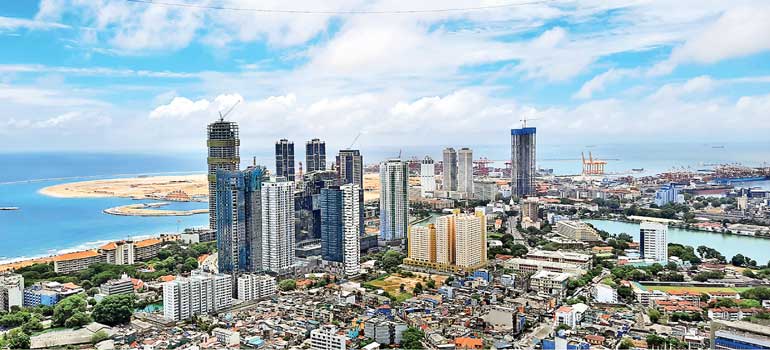Friday Jan 24, 2025
Friday Jan 24, 2025
Saturday, 17 July 2021 00:12 - - {{hitsCtrl.values.hits}}

An aerial view of a part of the Colombo city – Pic by Lasantha Kumara
Global giant Barclays Bank in its latest credit research has sounded upbeat, saying Sri Lanka is making ends meet despite challenges.
Funding lines obtained in recent months have reduced the risk of an imminent debt adjustment, Barclays said, recommending buy for Sri Lanka's Sovereign Bonds of 22 July/23 April.
"But questions remain about the sustainability of debt metrics, which will depend on the ability to boost economic activity in the next six-to-twelve months above pre-pandemic levels," it added.
“We recommend buying the SRILAN 5.875% 2022s and 5.75% 2023s, which are quoted at 85.086.5 and 75.25-76.75, respectively, following recent falls. We think the market was spooked by news that Ceylon Petroleum Corporation (CPC) had $ 2 b of loans with local banks that needed to be refinanced,” Barclays said.
“However, we do not consider CPC’s debt burden new news, as the risk from such large contingent liabilities, including those of the Ceylon Electricity Board (CEB), have been known for some time. For example, in early May, the CPC already reported a Rs. 21.8 b FX loss,” it said.
In Barclays’ view, the recent weakness in SRILAN bonds was triggered by ‘risk-off’ sentiment post the June FOMC meeting as well as some payback given Sri Lanka complex’s outperformance in Q2 after the PBoC swap line was confirmed.
It said Sri Lanka had secured a number of liquidity lines and new loans in recent months, which had reduced the risk of a need for a near-term readjustment of the country’s debt load; and Barclays expect local banks to rollover at least part of the SRILAN ’21s after the bond matures in late July.
Based on Government reported data, it estimates that $ 50 m of the SRILAN ’21s are owned by local banks.
Barclays believes this dynamic, combined with support from IMF SDR flows and expected activation of a RBI swap line in August, as well as the recent bond price weakness, has created good entry points for short-dated SRILAN bonds. Even if the Sri Lanka authorities were to decide to propose a debt adjustment, it said it would expect the front-end bonds to receive the most favourable treatment and see the highest recoveries (see Sri Lanka: Weighing the options, 27 October 2020).
“However, our medium-term concerns about the sovereign remain given its challenging external and fiscal position. Recent liquidity lines only provide stop-gap relief, hence we maintain an Underweight rating. In this regard, we believe a return of tourism will be key to support external flows and economic activity,” Barclays said.
It also noted Sri Lanka's improved liquidity position. Although Sri Lanka’s foreign reserves remain low ($ 4 b at end-May 2021), it thinks the immediate risk of a debt-adjustment event has eased. This is because Sri Lanka has secured a number of liquidity lines and loans with foreign central banks and agencies, which have eased funding pressures through near-term access to foreign currency.
It listed some of the funding lines as:
*Swap line with China: In March, the Central Bank of Sri Lanka (CBSL) and the People’s Bank of China (PBoC) entered into a three-year $ 1.5 b bilateral currency swap agreement. China Development Bank loan: The CDB agreed to disburse a $ 500 m loan to Sri Lanka in early April.
*Concessional loan from Korea: Sri Lanka secured concessional loans in May from the Economic Development Cooperation Fund (EDCF) and Export-Import Bank of Korea. The loans can be drawn down over 2021-2022 at 0.15-0.20% rates of interest with a repayment period of 40 years and a grace period of 10 years.
*Swap line with Bangladesh: In June, Bangladesh Bank approved a $ 200 m currency swap agreement with Sri Lanka.
*Swap line with India: The CBSL is reported to be resuming a $ 400 m swap line with the Reserve Bank of India, which it will be able to draw down from August.
*IMF Special Drawing Rights (SDR) allocation: Sri Lanka is eligible for $ 780-800 m from the IMF’s new allocation of SDRs.
*According to local papers, the Bank of Ceylon is expected to receive $ 115 m funding in the coming weeks – $ 70 m from China Development Bank (CDB) and $ 45 m from Asia Infrastructure Investment Bank (AIIB).
Barclays also said the debt outcomes shift for the front-end bonds.
“We believe the front-end Sri Lanka bonds, especially the 6.25% 2021s and 5.75% 2022s, have been the key beneficiaries of the positive news flow around extra liquidity lines and loans being secured, which we think has reduced the risk of a debt adjustment event.”
Bond prices reflect this: SRILAN 6.25% ’21s and SRILAN 5.75% ’22s are quoted at 97.25-98.50 and 92-25-94.25, respectively. In comparison, the SRILAN 5.875% 2022s and 5.75% 2023s, are quoted at 85.0-86.5 and 75.25-76.75, while the rest of the curve (2025 onwards) is trading around the 63-69 handle.
“We believe the relatively lower price points of the SRILAN 5.875% 2022s and 5.75% 2023s, which we view as short-dated bonds, offer good entry points as discussed,” it said.
It also said Sri Lankan authorities estimate that roughly $ 2.23 b of SRILAN bonds are owned by domestic investors. As this investor base likely mainly comprises of domestic banks, it believes the holdings are concentrated in the one-to-three-year tenors (2021-2023s), which implies that 30-40% of these bonds are locally owned.
“For the remainder of the year, $ 2.4 b of debt is due for repayment to foreign investors, according to the Central Bank. This debt includes the foreign owned component of the $ 1 b bond due in July 2021,” Barclays added.